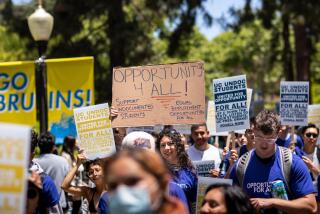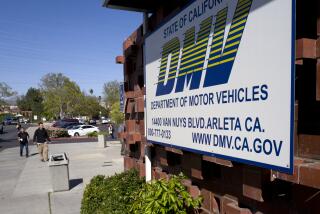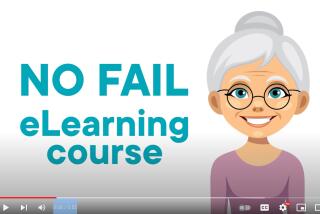Hit-and-runs fell after California gave driverâs licenses to those here illegally, study finds

A California law giving immigrants here illegally the ability to get driverâs licenses appears to have contributed to at least a 7% decrease in the rate of hit-and-run accidents in 2015. (Sign up for our free video newsletter here http://bit.ly/2n6V
A California law giving immigrants here illegally the ability to get driverâs licenses appears to have helped decrease hit-and-run crashes, according to a Stanford University study.
The controversial law, part of a larger effort by state officials to provide rights and services to California residents in the country illegally, resulted in more than 850,000 people getting driverâs licenses since Assembly Bill 60 took effect in 2015.
Supporters of the measure argued that it would make California roads safer because those here illegally would be forced to take driverâs tests and would be less likely to flee after crashes out of fear of being arrested or deported.
The Stanford study, released Monday, estimated that the rate of hit-and-runs decreased at least 7% in 2015 compared with 2014. Using a complex formula, the researchers concluded that there were 4,000 fewer hit-and-runs that year because of the new law.
The findings come as President Trump is vowing mass deportations as part of a crackdown on illegal immigration. That has put Trump in conflict with California, which over the last decade has tried to bring those here illegally into societyâs mainstream. Nearly 10% of the 11.1 million immigrants who are in the country illegally reside in Los Angeles and Orange counties alone, according to a recent report by the Pew Research Center.
The Department of Motor Vehicles would not release data on who received the new license on a county-by-county basis. So the research team of Hans Lueders, Jens Hainmueller and Duncan Lawrence had to estimate how many new licenses in each county were given to people here illegally.
Hainmueller, a political science professor, said in an interview that the team looked at driverâs licenses issued in the years before the law took effect. In 2015, the number of licenses issued in certain counties with large populations of people here illegally jumped dramatically. They then compared that data with hit-and-run records in those counties and determined the number of such crashes had decreased.
The study marked the first time researchers had tried to measure the effects of the policy change.
âWe were really interested in part because California is not the only state to have implemented this law,â said Lawrence, another study author and a political science researcher.
The AB 60 license is intended for people who cannot show proof of legal resident status in the United States, though it has limits. For example, a Californian couldnât use such a license to board an airplane or cross into Canada.
Some critics blasted California for giving out the licenses, saying it rewards people here illegally when they are committing a crime. Still, some law enforcement officials have praised the law, which they hope will make the roads safer.
Los Angeles Police Capt. Andrew Neiman, who recently took over as the head of the Valley Traffic Division, said numbers in his area have been mixed. Hit-and-runs rose in 2014, 2015 and 2016, he said, but declined by 3% in the first three months of 2017.
Still, the law was a âwin-win for both of the sides,â Neiman said.
âCommon sense says that if you teach people about the rules of the road and provide them with a test, then people are going to be better drivers and exhibit better behavior,â he said.
The hope, he added, is that âwe would have drivers who wouldnât be fearful about having cops arriving on the scenes.â
Hit-and-run data for the rest of Los Angeles wasnât immediately available.
Fran Clader, communications director for the California Highway Patrol, said that the licenses law didnât change the agencyâs operations, and that she could not say whether it had made the road safer.
âBut the simple fact that a driver has a license issued by the DMV indicates that that person has demonstrated the basic knowledge, skills and abilities to be driving,â Clader said.
The fact that a driver with an AB 60 license âhas gone through the process suggests that people around them are safer than someone who has never gone through that process,â Clader added.
Alison Kamhi, a staff attorney at the Immigrant Legal Resource Center, said the law was important because it essentially decriminalized driving for those here illegally as long as they have a license.
The law âhas been an overwhelmingly successful program,â Kamhi said. âItâs a big win for public safety. We know 850,000 people have passed a vision test and have proof of insurance.â
Twelve states and Washington, D.C., have similar laws on the books. Hainmueller said that New York state is currently debating a similar bill, and that the debate is occurring without much evidence about whether a law such as AB 60 is helpful.
âItâs shocking to see how you have these controversial debates and everyone is flying blind in terms of evidence,â Hainmueller said. âPeople in favor of it love it, and people against immigration hate it.â
Researchers posited that Californiaâs law gave people who may have been driving without a license a new confidence about being on the roads. Before, if a person driving illegally was involved in a fender-bender, he or she may have been worried about waiting for authorities to arrive. The studyâs findings suggest âthat, if anything, providing unauthorized immigrants access to driverâs licenses reduced their incentives to flee the scene of an accident,â the researchers wrote.
The study finds that a reduction in hit-and-runs should also have an economic benefit. If a crash occurs and the responsible driver flees the scene, then the hit-and-run victim â or his or her insurance company â must pay the damages.
The Stanford researchers estimate that $17 million a year could be transferred to drivers who cause crashes if they donât flee the scene.
UPDATES:
6:40 p.m.: This article was updated with more data and comments from the Los Angeles Police Department and the California Highway Patrol.
This article was originally published at noon.
More to Read
Sign up for Essential California
The most important California stories and recommendations in your inbox every morning.
You may occasionally receive promotional content from the Los Angeles Times.












